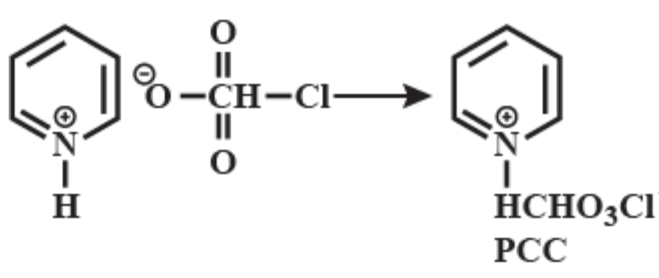
The formula of PCC is:
A.

B.

C.

D.





Answer
434.4k+ views
Hint: We know that PCC stands for pyridinium chlorochromate. Pyridinium chlorochromate is formed by the reaction of pyridine and chromium oxide, hydrochloric acid. You can now protonate the nitrogen atom present on the pyridine molecule and then perform the reaction. Based on this you can determine the possible structure of PCC i.e. pyridinium chlorochromate.
Complete step by step solution:
Pyridinium chlorochromate (PCC) consists of a pyridinium cation,

PCC is the most suitable reagent to oxidize primary alcohol to aldehydes and secondary alcohols to ketones without affecting any other functional group. Thus it offers any other functional group. In fact, it is more selective than the related Jones reagent, so there is little chance of over-oxidation to form carboxylic acids as long as the water is not present in the reaction mixture. It also converts suitable unsaturated alcohols and aldehydes to cyclohexanes. One disadvantage to the use of PCC is its toxicity. Another more convenient or less toxic reagent for oxidizing alcohols is dimethyl sulfoxide. PCC is soluble in solvents like acetone, acetonitrile.
Therefore, the correct answer is option B.
Note:
Remember that Generally, confusion may arise to choose in between options a and b. Pyridinium chlorochromate is formed by combining the compounds, pyridinium cation
Complete step by step solution:
Pyridinium chlorochromate (PCC) consists of a pyridinium cation,

PCC is the most suitable reagent to oxidize primary alcohol to aldehydes and secondary alcohols to ketones without affecting any other functional group. Thus it offers any other functional group. In fact, it is more selective than the related Jones reagent, so there is little chance of over-oxidation to form carboxylic acids as long as the water is not present in the reaction mixture. It also converts suitable unsaturated alcohols and aldehydes to cyclohexanes. One disadvantage to the use of PCC is its toxicity. Another more convenient or less toxic reagent for oxidizing alcohols is dimethyl sulfoxide. PCC is soluble in solvents like acetone, acetonitrile.
Therefore, the correct answer is option B.
Note:
Remember that Generally, confusion may arise to choose in between options a and b. Pyridinium chlorochromate is formed by combining the compounds, pyridinium cation
Recently Updated Pages
Master Class 9 General Knowledge: Engaging Questions & Answers for Success

Master Class 9 English: Engaging Questions & Answers for Success

Master Class 9 Science: Engaging Questions & Answers for Success

Master Class 9 Social Science: Engaging Questions & Answers for Success

Master Class 9 Maths: Engaging Questions & Answers for Success

Class 9 Question and Answer - Your Ultimate Solutions Guide

Trending doubts
Give 10 examples of unisexual and bisexual flowers

Draw a labelled sketch of the human eye class 12 physics CBSE

Differentiate between homogeneous and heterogeneous class 12 chemistry CBSE

Differentiate between insitu conservation and exsitu class 12 biology CBSE

What are the major means of transport Explain each class 12 social science CBSE

Why is the cell called the structural and functional class 12 biology CBSE




